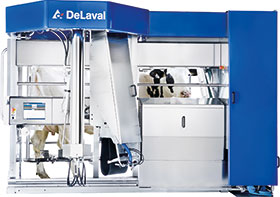

Dairy farming is a highly labour intensive agricultural endeavour. Cows have to be milked every day, year-round. Equipment has largely replaced manual procedures but someone still has to prepare each animal and then connect and disconnect the milking equipment. Just getting the cows to the equipment area can be a chore.
Engineers at DeLaval International, Sweden removed the human factor with a robotic voluntary milking system (VMS).Their ambitious goal was to make the experience so comfortable and enjoyable for the cows that each animal would return to the milking station voluntarily. The result was healthier, happier cows and improved milk quality.
The system starts by measuring each cow’s udder contours and storing the data in a central computer. The cows are attracted to the general area by scratching posts, salt licks and high quality feed. If a cow enters the milking stall adjacent to the VMS, the computer identifies her through an identity tag on her neck and checks the last time she was milked to ensure that she is not milked too often. If the computer determines that the cow is ready to be milked, the VMS closes the entrance door. The computer now calls up this cow’s dimensions, adjusts the stall to her length and dispenses feed to a manger to distract her from the milking. The dimensional information is also fed to an hydraulically powered robotic arm that performs the following operations: teat preparation and stimulation; removing teat cups from their magazine; locating the cow’s udder and teats; attaching the milking cups to the teats by opening a vacuum; holding the milk tubes in alignment during milking; and post spraying the teats after milking is complete.
The arm uses a camera and two adjacent lasers to assist in each of these operations through reflected laser beams. Guided by the camera, three hydraulic cylinders controlled by proportional directional valves generate all the arm motions. They quickly extend the arm the exact distance to reach the cow’s udders, attach the teat cups and start milking. Each cylinder moves the multi-purpose arm in a specific direction: cylinder A moves the upper and lower arms along the width of the milking station; cylinder B lifts the lower arm up or down; and cylinder C moves the lower arm along the length of the milking station. The multi-purpose arm also has three positional sensors to establish its position.
When a cow enters the station, a manure plate behind her swings forward toward the centre of the station and rests against the cow’s back legs. A sensor is connected to the rear plate to enable the arm to follow the cow’s movements in the station. This ensures reliable attachment of the milking cup.
The cylinders which carry out the milking process have to be both gentle to maintain the cow’s comfort and tough to cope with the number of cycles demanded of them. In addition, they have to deal with an aggressive environment that includes ammonia, water, and cow dirt. These low friction, double-acting
actuators have stainless steel piston rods, anodised aluminum profiled barrels and anodised cast aluminum end caps. They have magnetic pistons to feed position information back to the computer and are fitted with 2-component polyurethane rod seals to exclude contaminants.
The lower arm is fitted with a rotary actuator and an end effector, which carries the gripper and the camera and laser housing. The rotary actuator is driven by hydraulics, while the end-effector tilt cylinder and gripper are driven by compressed air. The rotary actuator can swivel the axis between the two end positions. The outer end of the end effector can be tilted between two positions in order to widen the search area for the camera. Sensors monitor all of the end positions. The gripper closes around the handle of a cup when it removes one from the magazine. Sensors check whether the gripper is holding a cup. The speed of rotation, tilting angle and gripping force can be adjusted.
The VMS has been used by farmers across the whole of Europe, Scandinavia, Russia, Oceania, China, Japan and US/Canada since January 2000. Visit http://tinyurl.com/p6ny684 to see this process in action.
For more information contact Johan ter Weele, DeLaval International, +46 85 306 6000, johanter.weele@delaval.com, www.delaval.com

© Technews Publishing (Pty) Ltd | All Rights Reserved